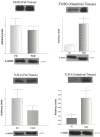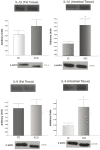Toll-like receptor 4, F4/80 and pro-inflammatory cytokines in intestinal and mesenteric fat tissue of Crohn's disease
- PMID: 23386912
- PMCID: PMC3560495
Toll-like receptor 4, F4/80 and pro-inflammatory cytokines in intestinal and mesenteric fat tissue of Crohn's disease
Abstract
Introduction: Crohn's disease (CD) is a chronic intestinal ailment with a multifactorial etiology, whose incidence has increased during the last three decades. Recently, a role for mesenteric fat has been proposed in CD pathophysiology, since fat hypertrophy is detected nearby the affected intestinal area; however, there are few studies on this aspect.
Aim: To evaluate inflammatory activity in intestinal mucosa and mesenteric fat tissue of patients with CD and controls.
Materials and methods: Ten patients with ileocecal CD and 16 patients with non-inflammatory disease (control groups) were studied. The specimens were snap-frozen and the expression of TLR-4, F4/80, IL1-β and IL-6 were determined by immunoblot of protein extracts. TLR4 RNA level were measured using RT-PCR. The t Test was applied (p<0.05). The local ethical committee approved the study.
Results: The intestinal mucosa of CD group had significantly higher protein levels of TLR-4, F4/80, IL-1β and IL-6 than the controls. The gene expression of TLR4 was lower in the intestinal mucosa of CD compared to the control group. Regard the mesenteric fat tissue, there was no statistical difference related to TLR-4, F4/80, IL-1β and IL-6 proteins expression.
Conclusions: These findings may result from an up-regulation of macrophage activation and intracellular pathways activated by bacterial antigens, which are more important in intestinal mucosa than fat tissue in CD patients. This may represent an anomalous regulation of innate immunity and could contribute to the production of proinflammatory mediators and disease development.
Keywords: Crohn’s disease; cytokines; inflammatory bowel disease; innate immunity.
Figures




Similar articles
-
Autophagy is decreased in mesenteric fat tissue but not in intestinal mucosae of patients with Crohn's disease.Cell Tissue Res. 2012 Dec;350(3):549-52. doi: 10.1007/s00441-012-1491-8. Epub 2012 Sep 5. Cell Tissue Res. 2012. PMID: 22948252
-
Increased Th17-inducing activity of CD14+ CD163 low myeloid cells in intestinal lamina propria of patients with Crohn's disease.Gastroenterology. 2013 Dec;145(6):1380-91.e1. doi: 10.1053/j.gastro.2013.08.049. Epub 2013 Aug 29. Gastroenterology. 2013. PMID: 23993972
-
Transcriptional and Molecular Pathways Activated in Mesenteric Adipose Tissue and Intestinal Mucosa of Crohn's Disease Patients.Int J Inflam. 2017;2017:7646859. doi: 10.1155/2017/7646859. Epub 2017 Apr 9. Int J Inflam. 2017. PMID: 28487813 Free PMC article.
-
Visceral adiposity and inflammatory bowel disease.Int J Colorectal Dis. 2021 Nov;36(11):2305-2319. doi: 10.1007/s00384-021-03968-w. Epub 2021 Jun 9. Int J Colorectal Dis. 2021. PMID: 34104989 Review.
-
Development, validation and implementation of an in vitro model for the study of metabolic and immune function in normal and inflamed human colonic epithelium.Dan Med J. 2015 Jan;62(1):B4973. Dan Med J. 2015. PMID: 25557335 Review.
Cited by
-
Mathematical Models Including microRNA Levels of Mesenteric Adipose Tissue May Predict Postoperative Relapse in Crohn's Disease Patients.Gastro Hep Adv. 2023 Sep 14;3(1):17-30. doi: 10.1016/j.gastha.2023.08.020. eCollection 2024. Gastro Hep Adv. 2023. PMID: 39132178 Free PMC article.
-
Downregulation of calponin 2 contributes to the quiescence of lung macrophages.Am J Physiol Cell Physiol. 2019 Oct 1;317(4):C749-C761. doi: 10.1152/ajpcell.00036.2019. Epub 2019 Jul 31. Am J Physiol Cell Physiol. 2019. PMID: 31365293 Free PMC article.
-
Interleukin-10 attenuation of collagen-induced arthritis is associated with suppression of interleukin-17 and retinoid-related orphan receptor γt production in macrophages and repression of classically activated macrophages.Arthritis Res Ther. 2014 Apr 16;16(2):R96. doi: 10.1186/ar4544. Arthritis Res Ther. 2014. PMID: 24742125 Free PMC article.
-
Lipopolysaccharide Regulation of Intestinal Tight Junction Permeability Is Mediated by TLR4 Signal Transduction Pathway Activation of FAK and MyD88.J Immunol. 2015 Nov 15;195(10):4999-5010. doi: 10.4049/jimmunol.1402598. Epub 2015 Oct 14. J Immunol. 2015. PMID: 26466961 Free PMC article.
-
Serum Levels of Lipopolysaccharide and 1,3-β-D-Glucan Refer to the Severity in Patients with Crohn's Disease.Mediators Inflamm. 2015;2015:843089. doi: 10.1155/2015/843089. Epub 2015 May 28. Mediators Inflamm. 2015. PMID: 26106258 Free PMC article.
References
-
- Cosnes J, Gower-Rousseau C, Seksik P, Cortot A. Epidemiology and natural history of inflammatory bowel diseases. Gastroenterology. 2011;140:1785–94. - PubMed
-
- Reinecker HC, Steffen M, Witthoeft T, Pflueger I, Schreiber S, MacDermott RP, Raedler A. Enhanced secretion of tumor necrosis factor-alpha, IL-6, and IL-1 beta by isolated lamina propria mononuclear cells from patient with ulcerative colitis and Crohn’s disease. Clin Exp Immunol. 1993;94:174–181. - PMC - PubMed
-
- Watanabe T, Higuchi K, Kobata A, Nishio H, Tanigawa T, Shiba M, Tominaga K, Fujiwara Y, Oshitani N, Asahara T, Nomoto K, Takeuchi K, Arakawa T. Non-steroidal anti-inflammatory drug-induced small intestinal damage is Toll-like receptor 4 dependent. Gut. 2008;57:181–187. - PubMed
LinkOut - more resources
Full Text Sources
